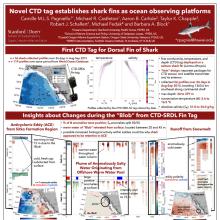Novel CTD tag establishes shark fins as ocean observing platforms
Camille
Pagniello
Hawaiʻi Institute of Marine Biology, University of Hawaiʻi at Mānoa
Poster
Animal-borne tags are effective instruments for collecting ocean data and can be used to fill spatial gaps in the observing network. We deployed the first conductivity, temperature, and depth (CTD) tags on a salmon shark fin (Lamna ditropis) to demonstrate the potential of sharks to monitor essential ocean variables and oceanographic features in the Gulf of Alaska. Over 1360 km and 36 days in the summer of 2015, the salmon shark collected 56 geolocated, temperature-salinity profiles. The shark swam through a plume of anomalously warm and salty water that originated from the “Blob,” a large patch of anomalously warm water in the northeast Pacific that appeared in the winter of 2013-2014 and persisted until 2016. The shark also encountered several mesoscale eddies, whose subsurface properties were altered by the marine heatwave. We demonstrate that salmon sharks have the potential to serve as submesoscale-resolving oceanographic platforms and substantially increase the spatial coverage of observations in the Gulf of Alaska.

Poster file
pagniello-camille-optimizing-poster.pdf
(7.27 MB)
